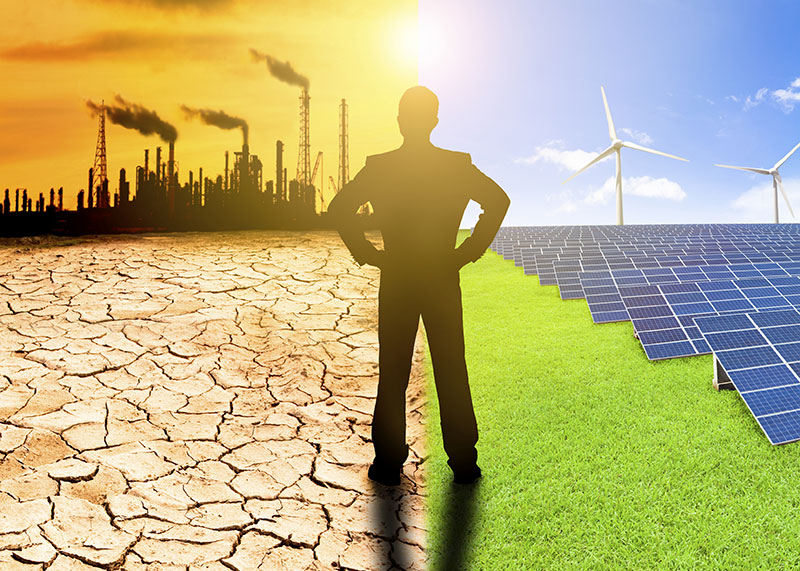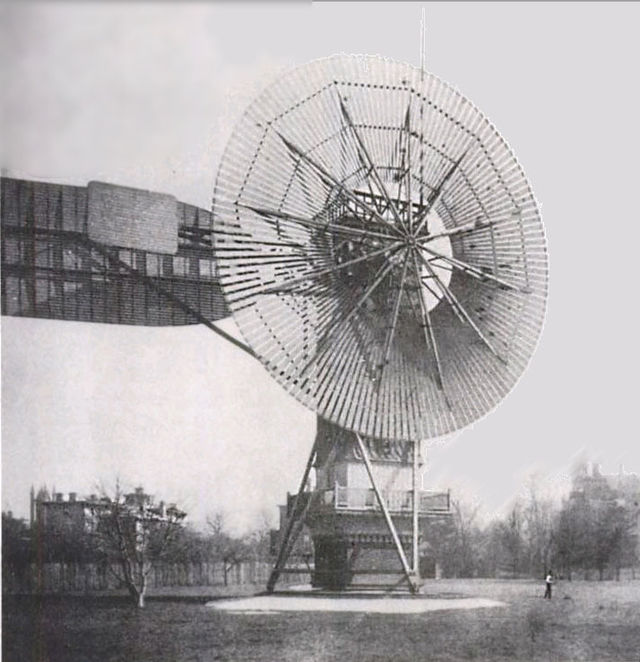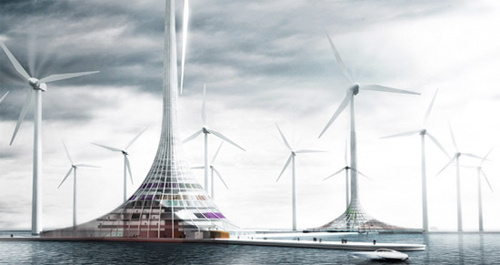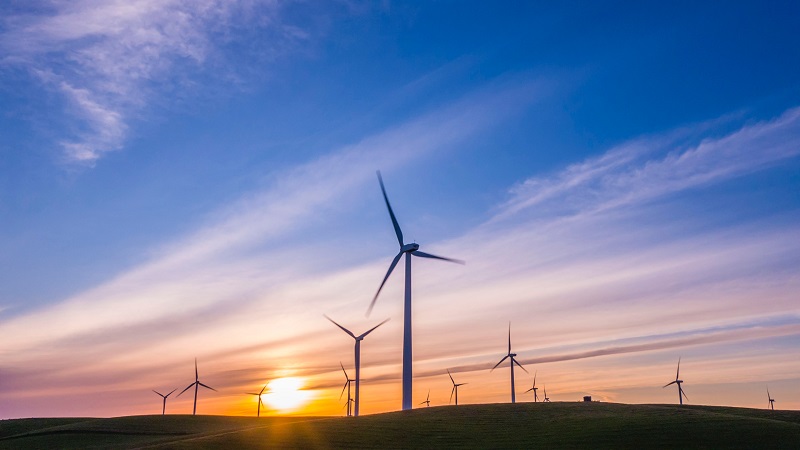Is Wind Energy Renewable or Nonrenewable – Wind energy is one of the byproducts of solar energy. Wind energy explains the process by which wind is utilized to produce electricity. Wind turbines convert the kinetic energy of the wind into the form of mechanical power. A generator then converts mechanical power into electricity. Mechanical power can also be employed directly for particular tasks such as pumping water.
Wind energy has been generally considered a renewable energy source. By and large, employing wind to generate energy has more negligible impacts on the environment than numerous other energy sources. Wind turbines do not produce emissions that can contaminate the air or water, and they do not need water for cooling. Wind turbines may also diminish the amount of electricity production from fossil fuels, which ends in lower carbon dioxide emissions and total air pollution.
Still, there is a critical question here: Is wind energy really a renewable form of energy? In this post, we are going to explore the answer to this question, but before that, we will describe some basic definitions and applications of wind energy.

What is Renewable Energy
Before proceeding to the history and definition of wind energy, let’s take a look at the description of renewable energy. Renewable energy, frequently referred to as clean energy, evolves from natural sources or continually replenished processes. For instance, sunlight or wind keeps shining and blowing, respectively, even if their availability depends on weather and time.
Now that we possess increasingly innovative and cheaper techniques to harness and retain wind and solar energy, renewables have become a more critical power source, estimating for more than one-eighth of U.S. generation. The development in renewables is also occurring at scales large and small, from solar panels installed on a home rooftop that can sell power back to the national grid to enormous offshore wind farms. Even some entire rural communities rely on renewable energy for cooking and lighting.
In contrast, nonrenewable energy involves fossil fuels such as coal, oil, and gas. Nonrenewable sources of energy are solely available in restricted amounts and take a prolonged time to replace. Suppose we pump gas at the station, then we are utilizing a limited resource refined from crude oil that has been around since ancient times.
Nonrenewable energy sources are also commonly found in particular sections of the world, making them more abundant in some countries than others. On the contrary, each country has access to sunlight and wind energy. Prioritizing nonrenewable energy can also promote national security by decreasing a country’s dependence on exports from fossil fuel-rich countries.
Numerous nonrenewable energy sources can threaten the environment or human wellness. For instance, oil drilling might need strip-mining Canada’s boreal forest, the technology linked with fracking can create earthquakes and water contamination, and coal power plants foul the air. Above all, these actions contribute to global warming.

History of Wind Energy
Humans have been utilizing wind energy for thousands of years. They adopted wind energy to thrust boats along the Nile River as early as 5,000 BC. By 200 BC, windmills with woven-reed blades were grinding grain in Persia and the Middle East, and simple wind-powered water pumps were employed in China.
Innovative ways to utilize wind energy ultimately developed around the world by the 11th century. People in the Middle East were applying wind pumps and windmills largely for food production. Dealers transferred wind technology to Europe in medieval. The Dutch used big wind pumps to drain lakes and marshes in the Rhine River Delta. Newcomers from Europe finally took wind energy technology to the Western Hemisphere.
American pioneers utilized windmills to grind grain, cut wood at sawmills, and pump water. Ranchers placed thousands of wind pumps as they settled the United States. In the late 1800s and early 1900s, tiny wind-electric turbines were also extensively used.
The number of wind pumps and wind turbines diminished as rural electrification plans in the 1930’s spread power lines to most ranches and farms across the country. Nevertheless, some farms still employ wind pumps to provide water for livestock. Miniature wind turbines are growing again, mainly to supply electricity in distant and rural areas.

Working Principle of a Wind Turbine
Here, we present some information on the principal performance of a wind turbine as well as various types and applications of wind turbines.
How a Wind Turbine Works?
Wind power means transforming wind energy into electricity by employing wind turbines. A wind turbine regularly has three propellers-like blades named rotors. The rotor is connected to a tall tower. On average, wind towers in domestic environments are about 20m high. The tower is so tall because winds are more substantial higher from the ground, and there is less of a buffeting impact.
Wind originates from atmospheric changes: changes in temperature and pressure cause the air to move around the earth’s surface. All of which is the result of sunshine, and in this way, wind energy is another sort of solar power.
A wind turbine harnesses the wind, which then provides a renewable energy source. The wind causes the rotor to spin; as the rotor rotates, the blades’ movement prompts a generator that produces energy. The motion of the blades rotating is kinetic energy. It is this power that we transform into electricity.
Wind power turns into electricity by magnets moving past stationary coils of wire recognized as the stator. As the magnets pass the stator, Alternative Current (AC) electricity generation happens. It is then transformed into DC electricity. This can charge batteries that store the electrical energy or supplies into a grid-interactive inverter for feeding energy into the electricity grid.
Types of Wind Turbines
There are two principal types of wind turbines: horizontal axis and vertical axis.
The majority of wind turbines are horizontal axis types: a propeller-style design with blades that revolve around a horizontal axis. This type of wind turbine is either upwind (the wind beats the blades before the tower) or downwind (the wind beats the tower before the blades). Upwind turbines also involve a yaw drive and motor, which turns the nacelle to maintain the rotor facing the wind when its direction shifts.
In contrast, several vertical axis wind turbines have not entered the utility-scale market (100 kW capacity and larger) to the same level as horizontal axis turbines. Vertical axis turbines fall into two main forms:
- Drag-based, or Savonius, turbines regularly have rotors with solid vanes that revolve about a vertical axis.
Lift-based, or Darrieus, turbines have a vertical, tall, airfoil style (some seem to have an eggbeater shape). The Windspire is a variety of lift-based turbines experiencing independent testing at the National Renewable Energy Laboratory’s National Wind Technology Center.
Applications of Wind Turbines
Wind Turbines are utilized in a diversity of applications – from generating electricity for a single home to harnessing offshore wind resources:
- Huge wind turbines, most frequently used by utilities to give power to a grid, range from 100 kilowatts to several megawatts. These utility-scale turbines are usually grouped in wind farms to generate massive amounts of electricity. Wind farms can consist of only a few or even hundreds of turbines, affording enough power for tens of thousands of apartments.
- Small wind turbines, usually up to 100 kilowatts, are generally close to where the produced electricity will be employed, for instance, next to homes, water pumping stations, or telecommunications dishes. Miniature turbines are sometimes attached to diesel generators, photovoltaic systems, and batteries. These systems are termed hybrid wind systems and are regularly used in remote areas, where a connection to the national grid is not feasible.
- Offshore wind turbines are utilized in many countries to harness powerful, steady winds found off of coastlines. The resource potential of the winds above U.S. coastal waters is sufficient to produce more than 4,000 gigawatts of electricity or almost four times the generating capacity of the present U.S. electric power system. It is clear that all of these resources will not be used, but this signifies a significant chance to provide power to extremely populated coastal cities.
The Reasons of Importance of Wind Energy
Wind energy is a vital and profitable source of energy for many reasons:
- It is sustainable. The wind has been and forever will be accessible to us. While specific days may afford more wind than others, it persists as an infinite source of energy. This suggests it ensures durability and will never run out.
- It’s a competitive energy source for the home. Utility businesses can offer wind energy to houses that can help to hedge against unpredictable fuel costs. This is a more secure choice than fossil fuels, which alternate depending on resources and worldwide prices.
- It leads to the making of jobs. In 2019, the wind industry produced 120,000 jobs over all states.
- The U.S. Bureau of Labor Statistics has predicted a 96% increase in wind energy-related jobs from 2016 to 2026, which will offer it as one of the fastest-growing professions in America.
- It’s much safer than its equivalents. Wind energy diminishes the amounts of nitrogen oxides and sulfur dioxide that contaminate the air when fossil fuels are burned. These declines in air pollution saved spending on medication from respiratory issues and asthma, creating $9.4 billion in public health profits in 2018 alone.
- It, directly and indirectly, creates revenue. Over 99 percent of wind fields are in rural regions. Since wind farms pay tax base in these regions, it makes new revenue to provides local jobs, fix roads, and fund law enforcement. For instance, in 2009, Invenergy’s High Sheldon wind farm began producing electricity, and the project’s gains were enough to exclude local taxes for the first eight years of the life of the project.
- Wind projects pay over $1.6 billion to local governments and state as well as individual landowners every single year.
- It is cost-effective. In fact, it’s free! Energy sources such as fossil fuels regularly alternate in price. In contrast, wind energy is ordinarily provided based on a fixed price over a long period, often around 20 years. Typically, wind farms compensate their carbon footprint in six months or less, which presents decades of zero-emission energy that replaces fossil fuel energy.
- It saves the value of water. Wind turbines don’t need water to generate electricity or for cooling purposes, unlike other renewable sources. Wind energy saves the use of billions of liters of water every year, which indicates it doesn’t pollute the water. Last year, wind energy production diminished water consumption at existing power plants by nearly 103 billion gallons, equivalent to 723 billion water bottles.
What Makes Wind a Renewable Resource?
The evidence that there is an endless supply of wind causes it to be a renewable source of energy. The same also goes for solar energy since the sun will shine forever, and there will eternally be wind; the amount just depends on the time and weather.
Wind energy generated through wind farms does not contaminate the earth with nitrogen dioxide, nitric oxide, or sulfur dioxide, smog, or acid rain, like many other forms of conventional fuels do. The U.S. Department of Energy (DOE) foretells that wind energy may limit 12.3 gigatons of greenhouse gases by 2050.
The wind is very much a sustainable source of energy. It applies kinetic energy that normally exists in the wind and transforms it into electrical energy that we can utilize to power anything and everything that works based on electricity. Wind power is sustainable because it is a source of energy that does not produce waste or create carbon emissions, acid rain, soot, smog, or global warming. Besides solar and waste to fuels, wind power is among the most reliable and most sustainable energy sources we can utilize.
Wind farms also obliquely preserve the country’s money by diminishing the costs spent on importing fossil fuels. Those stored amounts of cash can be employed to support domestic infrastructure, supporting make us more self-sufficient.
In 2019, wind energy was the source of approximately 7.2% of entire U.S. electricity production, which is sufficient to power 27.5 million houses. Wind energy also provided about 42% of the electricity produced from renewable energy sources. This was a massive jump from a few years before this, i.e. in 2012, the amount of wind energy delivered in the United States was at the point of being able to power 15 million houses.
Is Wind Power Considered as a Clean Energy?
The short answer to this question is “Yes”. Wind power is supposed to be green energy because it creates zero carbon emissions. Clean energy regards ways of producing electricity that generate no or minimal carbon emissions. In contrast, green energy points to renewable energy sources (solar, wind) with zero carbon emissions throughout operations.
It is essential to note this difference as numerous renewable (aka “green”) energy sources aren’t really suitable for the environment. For instance, we can burn garbage to produce electricity. Of course, we have been delivering non-recyclable waste for years, and until this turns, waste-to-energy will proceed to be a renewable source. It is a solution, but the smoke created contributes to climate variation and adversely impacts the atmosphere.
How is Wind Energy Beneficial to us?
Wind energy is helpful to us for the same purposes it is so essential to us. It preserves money, saves water, but most importantly, it does far less harm to the environment than its non-renewable equivalents. Wind turbines leave wildlife in their neighboring areas virtually totally unharmed and undamaged. Because wind energy does not need any water to plant, it is drought-proof, which is particularly appropriate in areas of the country that are likely to droughts. Also, the wind comes from a source that will always be accessible to us, so our sources will never drain.
Future of Wind Turbines
Wind energy will have a bright future. Here, we have listed some visions toward the future of wind energy.
- Wind energy is obtainable in general. The Wind Vision Report notes that wind can be a viable renewable electricity source in all 50 states by 2050.
- Wind energy supports a robust domestic supply chain. The wind can support over 600,000 jobs in manufacturing, establishment, preservation, and supporting services by 2050.
- Wind energy is affordable. As wind energy production contracts typically provide 20-year fixed pricing, the electric utility sector is expected to be less sensitive to fluctuation in natural gas and coal fuel prices with more wind. By diminishing national vulnerability to price spikes and supply interruptions with long-term pricing, the wind is expected to save consumers $280 billion by 2050.
- Wind energy diminishes air pollution emissions. Operating wind energy capacity avoided over 250,000 metric tons of air pollutants, including nitric oxide, nitrogen dioxide, sulfur dioxide, and particulate elements, in 2013. By 2050, wind energy could bypass the emission of 12.3 gigatons of greenhouse gases.
- Wind energy protects water resources. By 2050, wind energy can preserve 260 billion gallons of water, equivalent to approximately 400,000 Olympic-size swimming pools.
- Wind energy deployment improves community revenues. Local communities will collect additional tax revenue from land lease fees and property taxes, approaching $3.2 billion annually by 2050.

Buy Equipment or Ask for a Service
By using Linquip RFQ Service, you can expect to receive quotations from various suppliers across multiple industries and regions.
Click Here to Request a Quotation From Suppliers and Service Providers
Read More On Linquip




I read this post your post so nice and very informative post thanks for sharing this post.
Thanks for visiting our website and leaving your comment, Tom! We hope to hear from you again in our other posts.